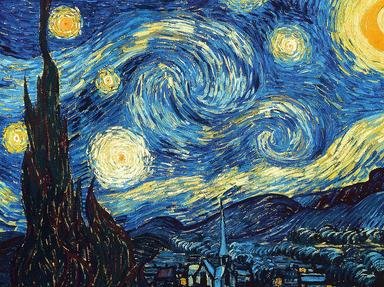Quiz Answer Key and Fun Facts
1. The green strokes sweep up, making leaves like we've never seen before! And now the petals. Blue. The odd white one. Interesting - the supporters will be glad to see a bit of variety in this painting.
Which type of flower (matching the commentary) did Van Gogh paint in 1889?
2. The birds are out on the field; we're just waiting for kick-off. Looks like there's a storm on the horizon. Hopefully it doesn't interfere too much with the game. The whistle blows and they're off! It's a race to the sky! Who will be first over the finish line?
Which 1890 Van Gogh painting featured birds against a stormy sky?
3. Visibility is good today. The sky's clear blue - not a cloud in sight. It really makes those pale flowers stand out. The branches are looking a bit bumpy but that's to be expected. There's nothing artificial here. It's a natural stunner!
What did Van Gogh paint for his new-born nephew in 1890?
4. We're in Auvers and the grey brushstrokes are surging up, carefully negotiating the stained-glass windows. Now, can they make it on to the roof? They're up and over! And look at the clock! No time at all!
Which medieval building in Auvers did Van Gogh paint in 1890?
5. We're back on the river in Arles and what a night it is! The gas lamps are burning and the yellow stars are bursting out of the sky. The couple on the bank cannot believe their eyes!
Which landscape did Van Gogh paint in 1888?
6. Blue door comes in, crosses to red tiled floor. Onions at the back but straw seat charges in front.
In 1888, which painting did Van Gogh create to accompany "Gauguin's Chair"?
7. The team of five have entered the arena. There's a hush of anticipation here - the crowd are holding their breath. The food's on the table and the coffee's been poured. Who will be first to pick up their fork?
Which Van Gogh painting featured five people, coffee, and a plate of food?
8. They think it's all over - it is now. The only thing left is smouldering tobacco.
Which painting did Van Gogh create while studying at an art school in Antwerp in 1886?
9. Yellow meets blue out on the street today. A crowd has gathered under the awning to watch the night unfold.
Which establishment did Van Gogh paint at night in 1888?
10. Of all the colours to choose from, only one is important here: yellow. A dash of green. Where will the paintbrush go? The stems weave upwards, heading for the sun. Touchdown!
Which yellow plant did Van Gogh paint multiple times between 1887 and 1889?
Source: Author
AcrylicInk
This quiz was reviewed by FunTrivia editor
ponycargirl before going online.
Any errors found in FunTrivia content are routinely corrected through our feedback system.
